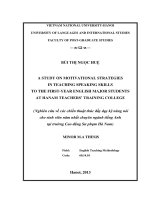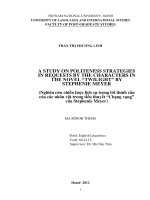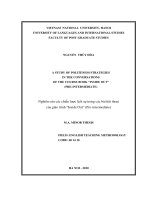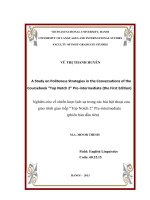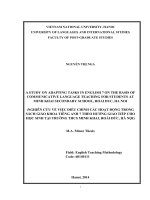A study on politeness strategies in negotiating conversations in market leader
Bạn đang xem bản rút gọn của tài liệu. Xem và tải ngay bản đầy đủ của tài liệu tại đây (309.34 KB, 7 trang )
A study on politeness strategies in negotiating
conversations in market leader
Nguyễn Thị Thanh Vân
Trường Đại học Ngoại Ngữ
Luận văn ThS. Chuyên ngành: English Linguistics; Mã số: 60 22 15
Người hướng dẫn: Assoc. Prof. Nguyễn Quang (PH.D)
Năm bảo vệ: 2009
Abstract: Although the nuances of politeness have been explored by many linguists for
decades, beginning with the pioneering works of Brown and Levinson (1987) and Leech (1983),
there has been little research focusing on politeness strategies in only negotiating activities. Most
researches on politeness strategies involve communicational conversations in general. Therefore,
within this study I would like to carry out an investigation and draw out the importance of
positive and negative politeness strategies in only the negotiating conversations of the course
book " Market Leader – Pre intermediate " by David Cotton, David Falvey and Simon Kent so as
to improve the teaching of communication in English to English as foreign language students,
especially the second year students at Hanoi University of Business and Technology. The study
used the combination of quantitative and qualitative methods as this study is mainly about the
practical aspects of cross-cultural communication. All the considerations and conclusions are based
on the analysis and reference. The study consists of the following parts: Part 1- the introduction
presents the rationale, aims of study, scope of the study and methodology. Part II- the
development includes three chapters. Chapter 1 is the theoretical background on speech act and
politeness strategies. Chapter 2 analyzes positive and negative politeness strategies found in the
negotiating activities of the course book "Market Leader – Pre intermediate". Chapter 3 presents
some implications for learning and teaching politeness strategies for the second year students at
Hanoi University of Business and Technology. Part III- the conclusion is the last part which
summarizes the obtained results of the study, limitations of the research and suggestions for
further study.I very much hope that this study would be of some help to improve teaching
politeness strategies to English as foreign language students
Keywords: Chiến lược lịch sự; Tiếng Anh; Bài hội thoại.
Content:
TABLE OF CONTENTS
Page
Astract
Acknowledgements
Abbreviations
Part 1: Introduction
1. Rationale ………………………………………………….……………………………. 1
2. Aims of the study……………………………………………………………………… 1
3.Scope of the study……………………………………………………………………… 2
4. Methodology…………………………………………………………………………… 2
5. Design of the study………………………………………………………………………. 2
Part 2: Development
Chapter1: Theoretical background………………………………………………………. 3
1.1. Speech Acts ……………………………………………………………………………. 3
1.1.1 What speech acts? ……………………………………………………………………. 3
1.1.2 Direct speech acts……………………………………………………………………… 5
1.1.3 Indirect speech acts…………………………………………………………………… 6
1.2. What politeness? …………………………………………………………………….…. 7
1.2.1 Face and politeness………………………………………… ………………………… 7
1.2.2 Positive politeness……………………………………………………………………. 11
1.2.2.1 What positive politeness? 11
1.2.2.2. Positive politeness strategies………………………………………………………. 11
1.2.3 Negative politeness………………………………………………………………… 15
1.2.3.1 What negative politeness? 15
1.2.3.2. Negative politeness strategies…………………………………………………… 15
Chapter 2: Politeness strategies in negotiating conversations in Market Leader (new
edition) – Pre Intermediate Business English
2.1. Negotiating conversations in the coursebook……………………………………… 19
2.2. Politeness strategies in negotiating conversations ………………………………… 19
2.2.1. The frequency of negative politeness and positive politeness strategies used in the
negotiating conversations…………………………………………… .………………… 20
2.2.1.1. Sampling process ……………………………………………….………………. 20
2.2.1.2. Balance of positive and negative politeness strategies used in negotiating
conversations……………………………………………………………………………… 21
2.2.1 Positive politeness strategies in negotiating conversations ………………….…… 22
2.2.2 Negative politeness strategies in negotiating conversations …………………….…. 26
Chapter 3: Implications for teaching politeness strategies to HUBT second-year students.
3.1. Preparation for training politeness strategies…………………………………………. 32
3.1.1. Preparation for students………………………………………………………… … 32
3.1.2. Making plans……………………………………………………………………… 32
3.2. Training politeness strategies for the HUBT second - year students…………….…… 36
3.2.1. Politeness strategy-awareness training……………………………………………… 36
3.2.2. One-time politeness strategy training…………………………………………… 37
3.2.3. Long-term politeness strategy training………………………………………….… 37
Part 3: Conclusion
1. Summary……………………………………………………………………….……… 39
2.Limitations………………………………………………………………………………. 40
3.Suggestions for futher study…………………………………………………………… 40
References
- 1 -
PART I: INTRODUCTION
1. Rationale:
It has been convincingly proved and widely accepted nowadays that an emphasis on
language as a communication system is really necessary in the age of globalization. Not only
does it help to uncover principles underlying social interactions, but it also enables us to gain
an access to ways of thinking, belief systems, and world views of people from various cultural
backgrounds. Investigating issues concerning cross-cultural communication is especially
momentous at present when national boundaries are becoming less visible, more and more
people are engaged in intercultural communication. Understanding social conventions and
paying attention to such concepts as politeness and face will certainly enable us to better
comprehend the different ways of speaking by people from different cultures, thus helping to
eliminate ethnic stereotypes and misunderstandings.
Knowledge of Anglophone cultures is obviously an important key for Vietnamese
students to succeed in learning English because second language learning is second culture
learning. In order to acquire the second language - English, it is necessary to learn not only
linguistic knowledge and interaction skills but also knowledge of the target culture. Cultural
factors are included in the course designs in universities and schools today. When
understanding the cultural factors, students have chances to expose themselves more
comfortably and confidently to native speaking environments. Normally, Vietnamese students
tend to employ English based on their own cultural experience and thus, causing
misinterpretations in communication. Hence, to communicate well across cultures the students
are well advised to be aware of their source culture as well as the target culture, especially
hidden parts of the latter including preferences in behaviour in everyday conversations.
Politeness really plays an important part in all social interactions. The author of this study takes
it as her goal to investigate positive and negative politeness strategies in negotiating
conversations of the course book “Market Leader – Pre intermediate” by David Cotton, David
Falvey and Simon Kent so as to improve the teaching of communication in English to the
second year students at Hanoi University of Business and Technology (HUBT).
- 2 -
2. Aims of the study
The study aims at
- Identifying and analyzing positive and negative politeness strategies in the negotiating
conversations of “Market Leader – Pre intermediate".
- Offering implications for teaching positive and negative politeness strategies in a
more effective way with cross - cultural activities and exercises.
3. Scope of the study
This study focuses on the positive and negative politeness strategies found in
conversational negotiating activities of "Market Leader – Pre intermediate”. It is only intended
for HUBT second year students.
4. Methodology
The major method employed is quantitative with due reference to qualitative method as
this study is mainly about the practical aspects of cross-cultural communication. All the
considerations and conclusions are based largely on analysis and reference. The main
approaches include:
- Reference to publications
- Discussion with supervisor
- Discussion with colleagues
- Discussion with students
- Personal observations
5. Design of the study
The study is divided into three parts:
Part 1: Introduction presents the rationale, aims of the study, scope of the study,
methodology and design of the study.
Part II: Development consists of three chapters. Chapter 1 provides the theoretical
background on speech acts and politeness strategies. Chapter 2 analyzes positive and negative
politeness strategies found in the negotiating activities of "Market Leader – Pre intermediate"
in terms of the frequency of occurrences. Chapter 3 offers some implications for learning and
teaching politeness strategies to HUBT second year students.
Part III: Conclusion summarizes the main findings, pointing out the limitations of the
research and giving suggestions for further study.
References
English
1. Austin, J.L (1962). How to do things with words, Oxford University Press: Oxford,
England.
2. Brown, P. & Levinson, S.C. (1987). Politeness: Some Universals in Language Usages.
CUP.
3. Cottrill, L. (1991) Face, politeness and Directness. University of Canberra.
4. Leech, G. (1983). Principles of Pragmatics. London and New York, Longman.
5. Levinson, Stephen C. 1983.Pragmatics. Cambridge, England: Cambridge University.
6. Searle, J. R. (1975). Speech Acts. CUP.
7. Gies, M.L. (1995) Speech Acts and Conversational Interactions. CUP
8. Thomas, J. (1995). Meaning in Interaction: An Introduction to Pragmatics. Longman,
London and New York.
9. Yule, G. (1996). Pragmatics, Oxford University Press.
10. Watt, R. (2003). Politeness. CUP.
Vietnamese
11. Nguyen Quang, (1996). Một số phạm trù giao tiếp văn hoá Việt - Mỹ trong hoạt động
giao tiếp. Tập san Ngoại Ngữ số 4.
12. Nguyen Quang, (1996). Vài suy nghĩ về hình thức x-ng hô trong ngôn ngữ. Nội san
Ngoại Ngữ số 2.
13. Nguyen Quang, (1998). Trực tiếp và gián tiếp trong dụng học giao văn hoá Việt - Mỹ.
Tập san Ngoại Ngữ số 4.
14. Nguyen Quang, (1999). Các t-ơng tác trực tiếp, gián tiếp và lịch sử trong dụng học
giao thoa văn hoá. Tập san Ngoại Ngữ số 4.
15. Nguyen Quang, (2001). Sắc thái quyền lực trong giao tiếp ngôn ngữ. Tập san Ngoại
Ngữ số 1.
16. Nguyen Quang, (2002). Các chiến l-ợc lịch sử d-ơng tính trong giao tiếp. Tạp Chí
Ngôn ngữ số 13.
17. Nguyen Quang, (2002). Giao tiÕp vµ giao tiÕp v¨n ho¸. Nhµ xuÊt b¶n §¹i häc Quèc gia
Hµ Néi.
18. Nguyen Quang (2003). Intracultural and Cross-culture Communication. VNU Press.
Internet
19.
20. />810001
21. Ardissono L., G. Boella and L. Lesmo. “Politeness and Speech Acts”. 10 January 2006.
<





